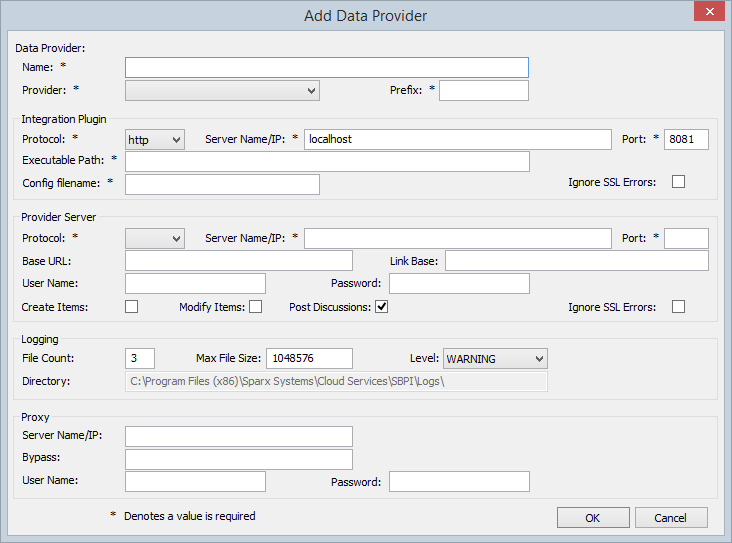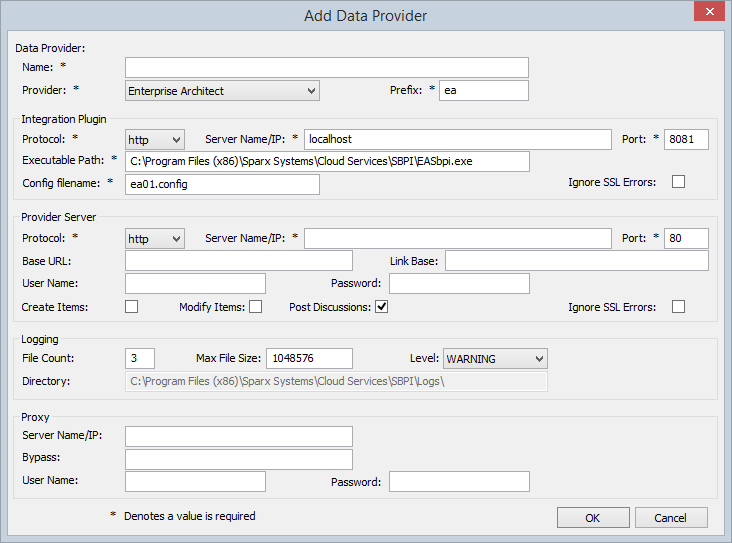Please note : This help page is not for the latest version of Enterprise Architect. The latest help can be found here.
| Prev | Next |
Add/Edit Data Provider
The 'Add/Edit Data Provider' screen will be shown whenever you request to create a new Data Provider or edit an existing one. The screen's behavior will be identical in either mode, the one difference being that the details of the selected Data Provider will be displayed when the screen loads in Edit mode.
When you choose to add a new Data Provider, the screen will initially display as shown:

Wherever possible the 'Add/Edit Data Provider' screen will fill each field with a default value in order to make it easier for you; if the default values are not correct, simply overwrite them. To this end, whenever the 'Provider' value is changed, a number of other fields will be set to the default values for the new Provider, such as the Data Provider's Prefix, the Integration Plugins' Executable Path and config filename, as shown here when Enterprise Architect is selected:

Note: When defining a Data Provider there are a number of mandatory fields (denoted with a '*') that require a value before a Data Provider can be saved.
Data Provider settings
Item |
Description |
See also |
|---|---|---|
|
Name |
This value represents the friendly name for the current Data Provider, it will be shown to users of Enterprise Architect. |
|
|
Provider |
This value specifies the Provider type of the current Data Provider; only supported values can be used. As mentioned, whenever this value is changed a number of other fields can be automatically updated to make data entry easier for the user. |
|
|
Prefix |
This value represents a short unique name to identify the current Data Provider. This value will be saved against every Enterprise Architect element that is linked to an external element. |
Integration Plugin settings
This group of settings related to the physical location of the Integration Plugin relative to the Integration Server, the combintation of Protocol, Server Name and Port must be resolvable by the machine hosting the Integration Server, so that requests can be forwarded to it. In the simplest case the Integration Plugin will reside in the same folder as the Integration Server, ie C:\Program Files (x86)\Sparx Systems\Cloud Services\SBPI
Item |
Description |
See also |
|---|---|---|
|
Protocol |
This value represents the protocol that the Integration Server should use to communicate to the Integration Plugin, in the simplest configuration this will be HTTP. |
|
|
Server Name/IP |
This value represents the Server Name or IP that the Integration Server should use to communicate to the Integration Plugin, in the simplest configuration this will be localhost (or 127.0.0.1). |
|
|
Port |
This value represents that the Integration Server should use to communicate to the Integration Plugin. Each Integration Plugin requires a unique Port number. The application automatically initializes this to 8081. |
|
|
Executable Path |
This value represents the physical path to the Integration Plugin executable file. If a value is specified the Integration Server will attempt to start this executable during it own startup routine. |
|
|
Config filename |
This value represents the physical filename of the configuration file for the current Integration Plugin, which must reside in the same folder as the Integration Plugin's executable. |
Provider Server settings
This group of settings relate to the details of the external data provider, ie Dropbox, Jira or TFS. The Integration Plugin will use the defined details to connect to the remote system and retrieve data from it so that it can be sent back to Enterprise Architect. The combination of Protocol, Server Name and Port must be resolvable by the server hosting the Integration Plugin, which in the simplest case is the Pro Cloud Server.
Item |
Description |
See also |
|---|---|---|
|
Protocol |
This value represents the protocol that the Integration Plugin should use to communicate to the external Data Provider. |
|
|
Server Name/IP |
This value represents the Server Name/IP that the Integration Plugin should use to communicate to the external Data Provider. |
|
|
Port |
This value represents the port that the Integration Plugin should use to communicate to the external Data Provider. |
|
|
Base URL |
Some external Data Providers allow for the concept of multiple repositories at a single location, for such Data Providers this field acts as a filter. For example it is possible to use another Enterprise Architect model as an external data source, in the case of Enterprise Architect the Protocol, Server & Port determine the Pro Cloud Server, the Base URL is the DB Alias of the repository. |
|
|
Link Base |
Some external Data Providers allow for the concept of elements providing a direct external link to themselves, for such Data Providers this field acts as a base URL that the individual element's unique identifier can be appended to. In the case of an Enterprise Architect external Data Provider, the Link Base field defines the WebEA address (including the model number) for the external data provider. ie "http://192.168.0.10?m=2" |
|
|
User Name |
This value represents the user name that should be used (in combination with the password) to access the data within the external system. If a value is defined in this field all Enterprise Architect users of the current Data Provider will use the same set of credentials to read the external system. Otherwise if the user name field is left empty, Enterprise Architect will prompt each user independently for their credentials. |
|
|
Password |
This value represents the matching password for the specified user name. |
|
|
Create Items |
Default value: unchecked This checkbox controls if Enterprise Architect users are able to create new items within the external system. |
|
|
Modify Items |
Default value: unchecked This checkbox controls if Enterprise Architect users are able to modify the details of external items within the external system. |
|
|
Post Discussions |
Default value: checked This checkbox controls if Enterprise Architect users are able to create discussions against elements within the external system. |
|
|
Ignore SSL Errors |
Default value: unchecked This checkbox controls if the Integration Plugin should ignore SSL related errors that occur as a result of communicating to the external system. |
Logging settings
This group of settings relate to the how the Integration Plugin will create entries in it's log file(s). Since the Integration Plugins run without user intervention, it is important for them to be able to write to any messages or potential problems to a log file. However special consideration must be made to ensure that performance isn't impacted by writing to such files, which is possible if the log file continually grows without limits. It is also unreasonable to expect that manual intervention should be required to ensure that the size and number of log files don't impact performance. For these reasons each Integration Plugin has it's own set of log files and configuration options to manage its log files.
The current log file will always include a '1' on the end of its filename. A new log file will be created whenever the Integration Plugin is started or the physical size of the current log file reaches the Max File Size. When this occurs all existing files will be 'rolled over', meaning their file numbers will be incremented and a new '{filename}1.log' created. If the roll over process causes more files to exist than the 'File Count' setting allows, these additional files will be deleted.
Item |
Description |
See also |
|---|---|---|
|
File Count |
Default value: 3 This value represents the 'rolling' number of log files that should be retained for the current Integration Plugin. |
|
|
Max File Size |
Default value: 1048576 This value represents the maximum number of bytes a log file can be before a new one is created. |
|
|
Level |
Default value: WARNING This value represents what maximum level of messages that should be written to the log file. The levels are: OFF, FATAL, WARNING, INFO and SYSTEM. A defined log level is inclusive of all lower levels, therefore if a Plugin is set to a log level of INFO then all FATAL, WARNING and INFO messages will be written to its log file. |
|
|
Directory |
(READ-ONLY) This field displays the physically location of where the log files for the current Data Provider will be saved. |
Proxy settings
This group of settings relate to how the Integration Plugin should communications to the External Data Provider when they are separated by a Proxy Server.
Item |
Description |
See also |
|---|---|---|
|
Server Name/IP |
The server name (or IP) and port number of the Proxy Server. ie proxyserver.com:3131 |
|
|
Bypass |
This field provides a mechanism for certain addresses to bypass the proxy; it accepts multiple values separated by semi-colons (;). For example, 192.168.*;*.localdomain.com;www.mydomain.com |
|
|
User Name |
If the Proxy Serer requires credentials, then enter the user name into this field. |
|
|
Password |
If the Proxy Serer requires credentials, then enter the password into this field. |